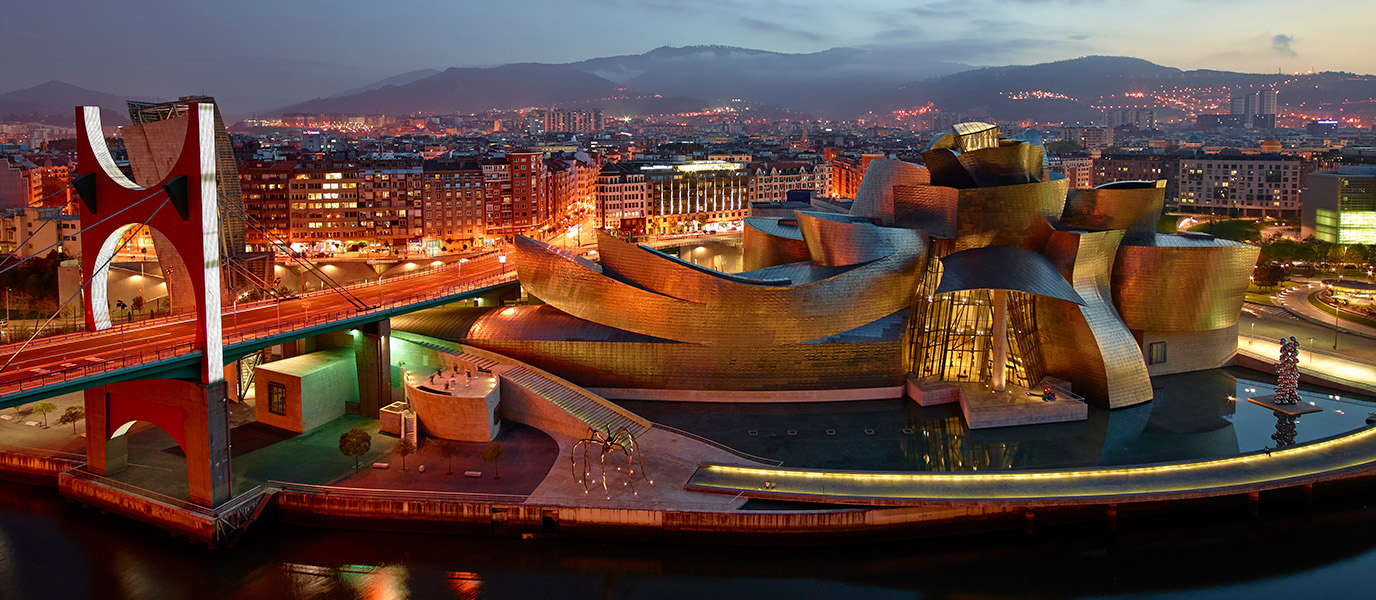In the early 1990s, the people of Bilbao were still able to observe, from the La Salve bridge, how the Nervión river embraced the Campa de los Ingleses, a grey industrial area situated on the left bank of the river whose name recalls the British cemetery that it was home to until 1908. Today it is the site of the Guggenheim Museum Bilbao, the central axis of the astonishing process of transformation that the capital of Biscay underwent at the end of the last century in response to the grave industrial crisis that the city was undergoing at the time. Mementos of this bitter but inevitable steel age are found in this temple of contemporary art, which harmoniously blends into Bilbao’s urban landscape, with the green Paseo de Abandoibarra as its main access point. The space is divided into a permanent collection, comprised of works by international artists, and a series of exhibitions that are changed regularly. The building’s undulating forms and captivating materials take shape in the ground-breaking design that the architect Frank Gehry conceived almost 25 years ago.
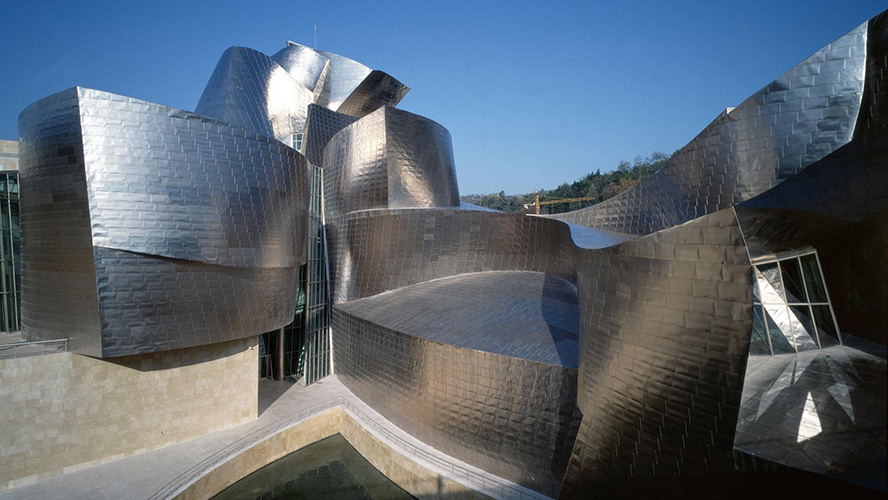
Frank Gehry and the Bilbao Effect
“The design of the Museum is based on the port that [Bilbao] once was and the city that it is,” said the Canadian-American architect Frank Gehry, the building’s chief designer, to explain the origins of the contentious design that today embodies the Guggenheim Museum. In effect, this large-scale sculpture maintains a kind of dialogue with the river that borders it. Some see the image of a stranded ship within it; others see the city in which it lies, alluding to its industrial past and its former identity as a port through its materials, chiefly its metal scales. This architectonic landmark of the twentieth century is situated in the north of the city, at the exact point its creator indicated quite flippantly, so they say, on a visit to the city while observing a panorama of the area from up on Mount Artxanda.
Co-financed by the Basque Government and the famous Solomon R. Guggenheim Foundation, it took exactly four years to build. In 1997, coverage of its inauguration travelled around the world, making the museum a success in terms of visitor numbers from day one, which as a result gave the Bilbao economy a revitalising boost. It’s hardly surprising then that the phenomenon of a city’s transformation by means of the building of an important architectonic piece has become known hereafter as the Bilbao Effect.
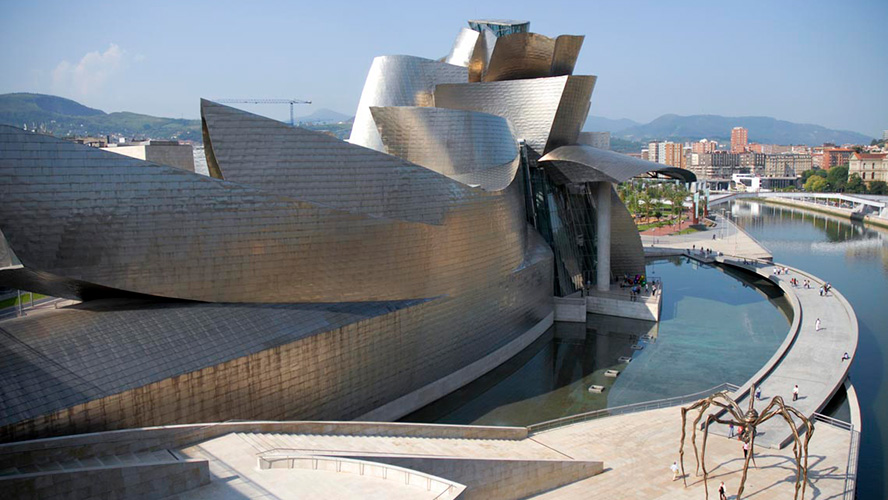
The Guggenheim from the outside
A gigantic dog covered in flowers called Puppy, by the American artist Jeff Koons, makes the presence of the Guggenheim known even from Calle Iparraguirre, the museum’s main access point. As we get closer, we encounter other pieces such as Maman, the spine-tingling giant spider by Louise Bourgeoise, or Fog Sculpture, an artwork by the Japanese artist Fujiko Nakaya.
According to Gehry himself, when he was in his studio in New York, he by chance came across a small piece of titanium and, moved by its curious nature, he decided to hang it from a telephone pole that could be seen from his window. Thanks to the rain that fell that day, Gehry was able to observe that the titanium had taken on a golden tone. He therefore decided that it would be the main material of the building’s façade. Today the museum’s suggestive forms, together with the finish of almost 33,000 extremely fine sheets of titanium, limestone and glass, harmonise perfectly in a spectacular vista made up of light reflections and mirrors.
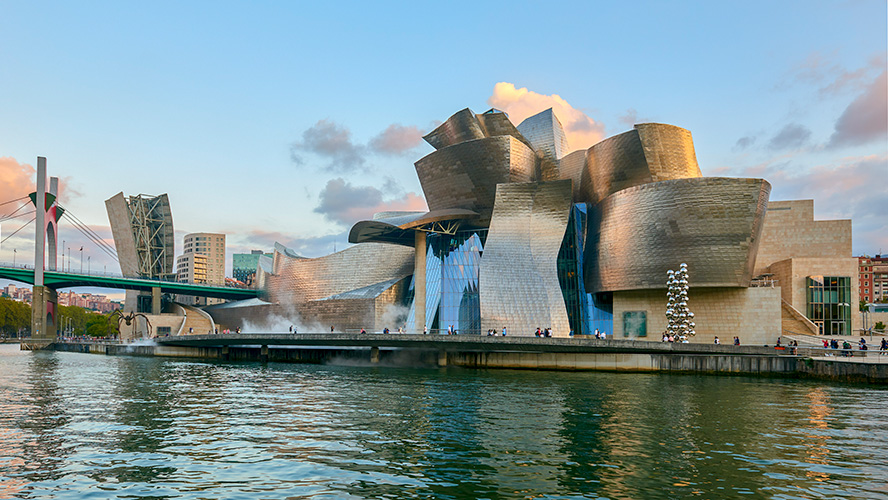
An exclusive journey through international contemporary art
Inside the building the spectacle continues. The Atrium, the true heart of the museum, welcomes us with an extraordinary zenithal skylight and its voluminous curves. From this light-flooded hall with its curved walkways, titanium and glass lifts and staircases, it is possible to access any of the twenty galleries that the museum is comprised of, including the ArcelorMittal room, an enormous 30 x 130 metre gallery that permanently houses the installation by the American artist Richard Serra, The Matter of Time, made up of seven monumental sculptures made from corten steel.
James Rosenquist, Eduardo Chillida, Andy Warhol, Robert Rauschenberg, Jannis Kounellis and Yves Klein are just some of the artists whose works appear in the museum’s permanent collection—in part thanks to the partnership with the Solomon R. Guggenheim Foundation—spanning works made between 1952 (Untitled, by Mark Rothko being the oldest) and 2014 (Wish Tree for Bilbao, by Yoko Ono, being the most recent).
In addition to this are the temporary exhibitions that the museum frequently organises, in the form of not only paintings and sculptures but also performances, installations, audiovisuals and other genres of art. What’s more, it is common to find a wide range of complementary activities such as conferences and talks, with which visitors can enrich their art knowledge on the topic in question.
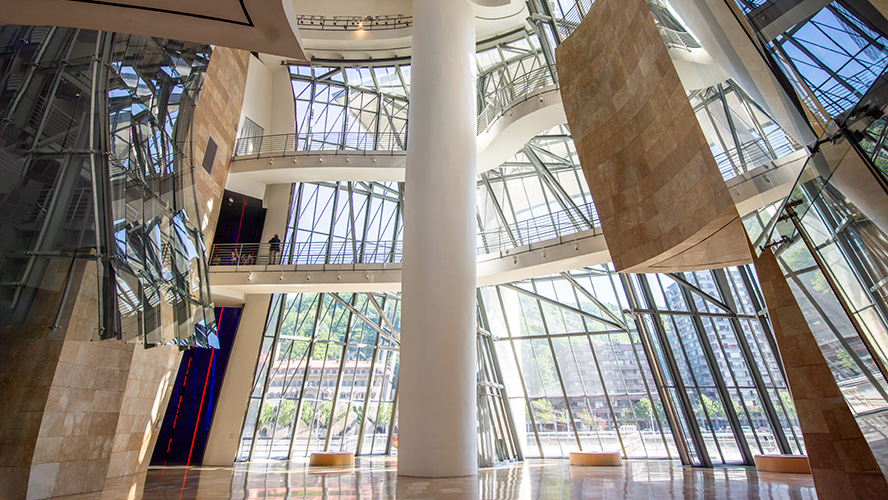
Some extra cultural and gastronomic incentives
To round off the incredible cultural offerings that the museum has for visitors, we also recommend the so-called Art After Dark, a night-time tour of the aforementioned exhibitions, with the Atrium as the meeting point and live performances from well-known DJs. This event, with a distinctly alternative feel, has taken place every last Friday of the month since 2008 and, since then, has offered visitors a fresh and unusual perspective to the Guggenheim’s usual day visits.
We also suggest stopping at one of the two restaurants that the museum provides for visitors. Nerua, with a more formal style, or Bistró Guggenheim Bilbao, more casual and relaxed, combine traditional Basque cuisine with new culinary trends and styles, so that your visit to the Guggenheim can be remembered not just with images but also flavours.
© FMGB Guggenheim Bilbao Museoa, 2024, Bilbao. Photo:Erika Barahona Ede. All rights reserved. Reproduction in whole or in part is prohibited.




































































